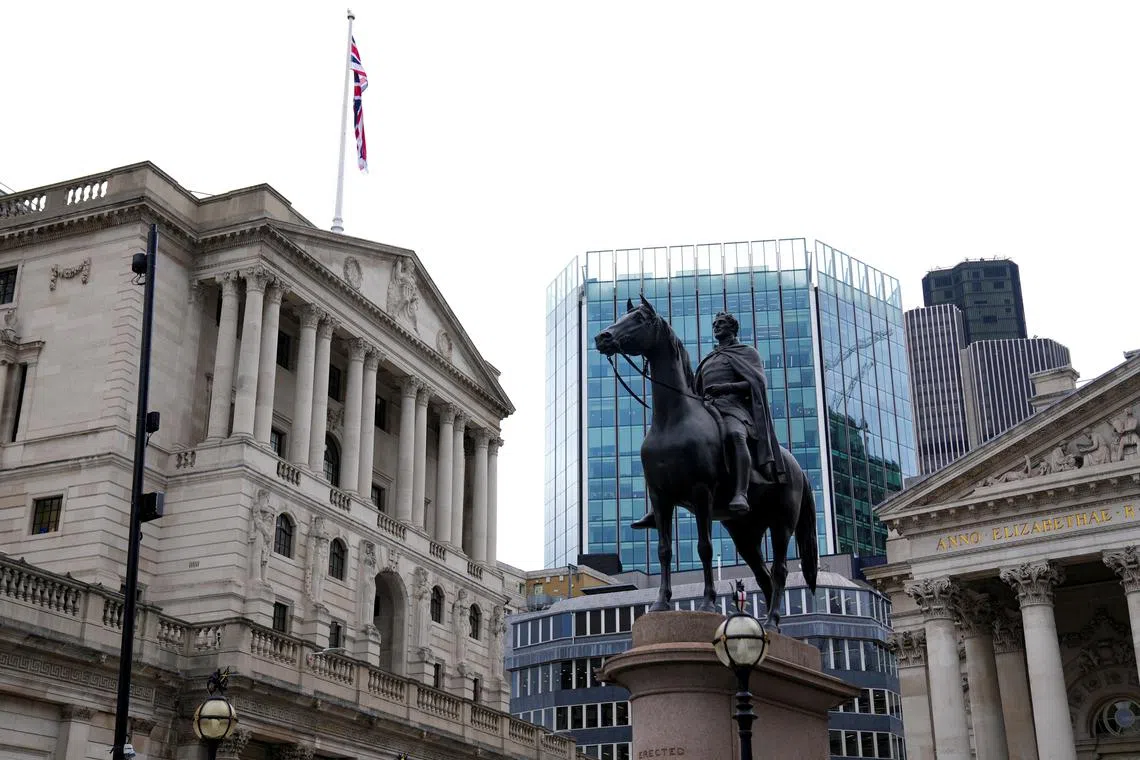UK wage growth hits six-month high ahead of crunch BOE meeting
Sign up now: Get ST's newsletters delivered to your inbox

Concerns about lingering inflation pressures have convinced the Bank of England to ease policy just twice since August 2024.
PHOTO: REUTERS
Follow topic:
UK employment plunged in the weeks after the Labour government increased payroll taxes in its first budget, reinforcing the case for the Bank of England (BOE) to continue cutting interest rates.
Data based on tax records showed the number of employees on payroll at the lowest level in over a year after falling by 47,000 in December – the largest drop since the end of 2020 when the country was under Covid-19 restrictions. It was a second consecutive decline that will add to concerns that Labour’s £26 billion (S$43.3 billion) hike in employers’ national insurance is causing firms to shed workers.
Signs of a weakening labour market are a headache for Chancellor of the Exchequer Rachel Reeves, but pave the way for the BOE to deliver a third rate cut in just over two weeks. Separate figures showed wage growth picking up in the three months to November, although forecasters pointed to strong base effects lifting the figures.
“The looser labour market will reinforce the odds of a February rate cut,” said Mr Sanjay Raja, Deutsche Bank’s chief UK economist. “The labour market is showing signs of wear and tear as weak demand and higher payroll costs start to weigh on employment.”
Pay excluding bonuses rose 5.6 per cent in the three months to November from a year earlier, up from 5.2 per cent in the previous month, the Office for National Statistics said on Jan 21. It was the strongest in six months and slightly above the 5.5 per cent expected by economists. Private-sector pay growth, the gauge most closely watched by the BOE, accelerated to 6 per cent from 5.5 per cent.
But in further signs of weakening activity, vacancies dropped by 24,000 in the three months to December – compared with the previous quarter – to 812,000, the 30th consecutive drop. Unemployment also edged up to 4.4 per cent in the three months to November, from 4.3 per cent in the three months to October, although officials have expressed caution over the accuracy of the UK’s jobless data.
“The rise in pay growth is expected to be short-lived as the labour market faces headwinds,” said Ms Yael Selfin, KPMG UK’s chief economist.
She pointed to a rise in unemployment and said the increase in wage growth was “largely due to base effects”.
“We expect pay growth to trend downwards over the coming year, with the backdrop of slowing labour market activity.”
The Institute of Directors said the figures “should set alarm bells ringing” and urged the government to soften its plans to beef up worker rights.
The pound pared losses after the data, following a broader move on the US dollar, and was down 0.5 per cent to US$1.2268. Meanwhile, traders slightly increased the amount of interest rate cuts they see the BOE delivering in 2025, in line with a move in expectations for other major central banks. Money markets now price 63 basis points of easing, which means two quarter-point reductions plus a 52 per cent chance of a third.
Interest rates
The figures come just over two weeks before the BOE decides whether to press ahead with more rate cuts, with the state of the labour market crucial to the outcome. Concerns about lingering inflation pressures have convinced the BOE to ease policy just twice since August, leaving the central bank lagging behind its euro zone and US peers.
With pay still rising much faster than prices, households enjoyed the fastest inflation-adjusted wage gains since August 2021. Real wage growth picked up to 3.4 per cent in the three months to November.
BOE governor Andrew Bailey has signalled a “cautious” approach to further easing. However, officials have played down the recent uptick in wage growth, with surveys showing the labour market cooling in response to a faltering economy.
“The MPC (Monetary Policy Committee) is likely to dismiss the stronger pay growth as volatility and focus on the weakness in economic growth and slower-than-expected inflation,” said Mr Thomas Pugh, economist at RSM UK. “A rate cut in February is still a sure bet. However, strong wage growth will keep the MPC cautious through this year.”
Inactivity, the number of people out of work and not looking for employment, fell by 54,000 to 9.3 million. Within that, however, the number of long-term sick picked up by 21,000 to 2.8 million. The statistics office says the figures need to be treated with caution as the data set is not reliable at the moment. BLOOMBERG

